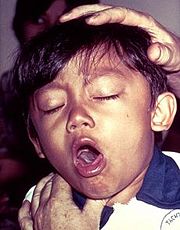Pertussis Toxin-ATP Complex
From Proteopedia
(Difference between revisions)
| Line 9: | Line 9: | ||
==Pertussis Toxin activation== | ==Pertussis Toxin activation== | ||
| - | '''Pertussis Toxin''' by itself is harmless unless activated. From multiple studies, it has became clear that there is a direct interaction between [http://en.wikipedia.org/wiki/Adenosine_triphosphate Adenosine triphosphate] (ATP) and pertussis toxin which leads to activation. The direct effect of ATP is to destabilize the interaction between the S1 subunit and the B-oligomer by binding to the B-oligomer. | + | '''Pertussis Toxin''' by itself is harmless unless activated. From multiple studies, it has became clear that there is a direct interaction between [http://en.wikipedia.org/wiki/Adenosine_triphosphate Adenosine triphosphate] (ATP) and pertussis toxin which leads to activation. The direct effect of ATP is to destabilize the interaction between the S1 subunit and the B-oligomer by binding to the B-oligomer.<ref name=Hazes>PMID: 8637000</ref> This interaction relaxes the toxin by facilitating the subsequent reduction of a disulphide bond in the S1 subunit. The main interaction that leads to the destabilization is the favorable hydrogen bonding and electrostatic interaction between the triphosphate moiety and five positively charged amino acids:<scene name='Pertussis_Toxin-ATP_Complex/5_amino_acid_interaction/4'>Arg S2-150, Arg S3-150, Arg S3-151, Arg S4b-69, and Lys S2-151</scene>. In contrast, the negatively charged carboxyl terminus of subunit S1 interacts unfavorably with the negative charges of the triphosphate moiety, causing a displacement of the C-terminal of <scene name='Pertussis_Toxin-ATP_Complex/Repulsion_of_subunit_s1/3'>Tyr 233:A and Phe 235:A</scene> therefore, the repulsion between the triphosphate moiety and the C terminus of subunit S1 forms the mechanism by which the interaction between S1 and the B-Oligomer is destabilized. The details of the [http://proteopedia.org/wiki/images/9/94/PT_ATP_complex.png protein-ATP interactions] can also be seen here.<ref name=Hazes>PMID: 8637000</ref> |
==Mechanism of pathogenesis== | ==Mechanism of pathogenesis== | ||
Revision as of 05:58, 12 November 2011
| |||||||||||
References
- ↑ 1.0 1.1 1.2 1.3 Hazes B, Boodhoo A, Cockle SA, Read RJ. Crystal structure of the pertussis toxin-ATP complex: a molecular sensor. J Mol Biol. 1996 May 17;258(4):661-71. PMID:8637000 doi:10.1006/jmbi.1996.0277
- ↑ Carbonetti NH. Immunomodulation in the pathogenesis of Bordetella pertussis infection and disease. Curr Opin Pharmacol. 2007 Jun;7(3):272-8. Epub 2007 Apr 5. PMID:17418639 doi:10.1016/j.coph.2006.12.004
- ↑ Bettiol S, Thompson MJ, Roberts NW, Perera R, Heneghan CJ, Harnden A. Symptomatic treatment of the cough in whooping cough. Cochrane Database Syst Rev. 2010 Jan 20;(1):CD003257. PMID:20091541 doi:10.1002/14651858.CD003257.pub3
- ↑ Weiss AA, Johnson FD, Burns DL. Molecular characterization of an operon required for pertussis toxin secretion. Proc Natl Acad Sci U S A. 1993 Apr 1;90(7):2970-4. PMID:8464913

